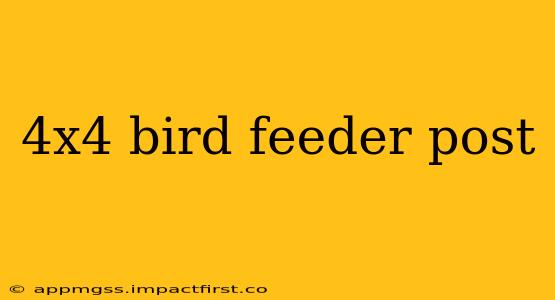Attracting feathered friends to your backyard is a rewarding experience, and a sturdy 4x4 bird feeder post is the perfect foundation for a thriving bird feeding station. This guide delves into everything you need to know about building and placing a 4x4 bird feeder post, ensuring you create a safe and inviting haven for your avian visitors. We'll cover everything from material selection to deterring predators, making this your ultimate resource for a successful bird feeding setup.
Why Choose a 4x4 Post for Your Bird Feeder?
A 4x4 post offers superior stability and durability compared to thinner options. Its robust structure can withstand harsh weather conditions, including strong winds and heavy snow. This stability is crucial, especially when supporting multiple feeders or heavier designs. Furthermore, the larger surface area allows for easier attachment of various feeders and accessories.
What Materials Will I Need?
Building your 4x4 bird feeder post requires a few key materials:
- 4x4 Pressure-Treated Lumber: Opt for pressure-treated lumber to ensure longevity and resistance to rot and insect damage. The pressure treatment protects the wood from the elements and extends its lifespan, minimizing the need for frequent replacements.
- Post Base: A concrete post base provides the most secure foundation, preventing the post from tipping or sinking into the ground. Alternatively, you could use a metal post base or even bury the post deep into the ground with surrounding gravel for added stability.
- Concrete Mix: If using a concrete base, you'll need a ready-mix concrete or the components to create your own mix.
- Hardware: This includes screws, bolts, washers, and possibly brackets, depending on your feeder design and attachment method. Choose galvanized or stainless steel hardware for rust resistance.
- Optional: Protective Coating: While pressure-treated lumber is already resistant to the elements, you can add an additional layer of protection with a weather-resistant sealant or paint. This can improve the post's aesthetics and further extend its life.
How to Build a 4x4 Bird Feeder Post: A Step-by-Step Guide
- Prepare the Post: Cut the 4x4 post to your desired height. Remember to consider the height of your feeders and the surrounding vegetation.
- Set the Post Base: Dig a hole deep enough to accommodate your post base and a significant portion of the 4x4 post. For a concrete base, ensure the hole is appropriately sized for the base and allows for adequate concrete support around the post.
- Secure the Post: Carefully place the post into the post base, ensuring it is plumb (perfectly vertical). Fill the hole with concrete mix, firmly packing it around the post to create a solid foundation. Allow the concrete to fully cure according to the manufacturer's instructions before proceeding.
- Attach Feeders: Once the concrete is cured, you can securely attach your bird feeders using appropriate hardware. Consider using multiple feeders at different heights to accommodate various bird species.
- Optional: Add a Roof or Shelter: A simple roof or shelter can protect the feeders and the post from harsh weather, ensuring the longevity of your bird feeding station.
What is the Best Height for a Bird Feeder Post?
The ideal height for your bird feeder post depends on several factors, including the surrounding landscape and the types of birds you want to attract. Generally, placing the feeders between 4-6 feet above the ground is a good starting point. This height offers enough clearance to prevent ground predators from reaching the feeders while still providing a safe and accessible location for birds. Consider the height of surrounding shrubs and trees to avoid creating easy access points for predators.
How Do I Protect My Bird Feeder From Squirrels?
Squirrels are notorious for raiding bird feeders. Here are a few strategies to deter them:
- Squirrel-Resistant Feeders: Invest in feeders specifically designed to prevent squirrel access. These often incorporate baffles, cages, or other deterrents.
- Placement: Position the feeders away from trees or other structures that squirrels can easily use to access the feeders.
- Baffles: Install baffles on the post below the feeders to prevent squirrels from climbing up.
How Often Should I Clean My Bird Feeder?
Regular cleaning of your bird feeders is crucial to prevent the spread of disease among birds. Clean your feeders at least once a month, or more frequently if you notice any signs of mold, mildew, or excessive seed debris. Use a mild soap and water solution to clean the feeders thoroughly, rinsing them well before refilling.
By following this comprehensive guide, you can build and maintain a durable and effective 4x4 bird feeder post, attracting a variety of birds to your backyard for years to come. Remember to prioritize safety and hygiene to ensure the well-being of your feathered visitors.
